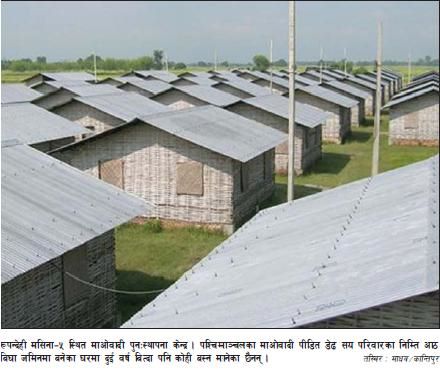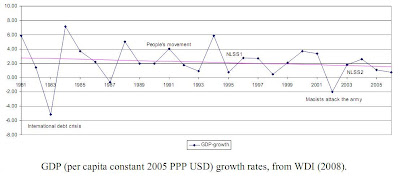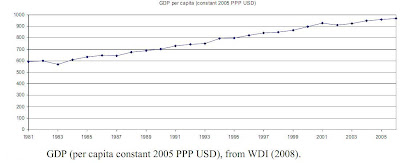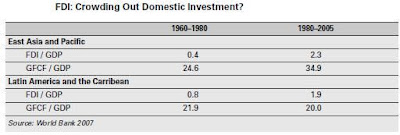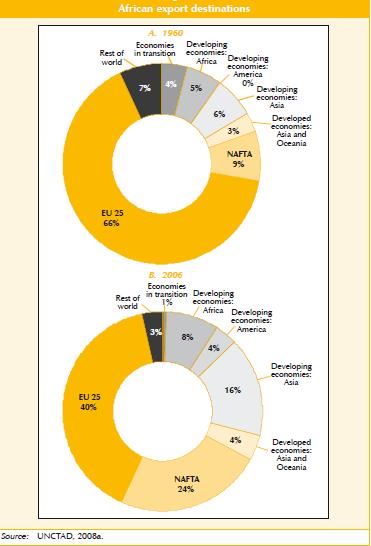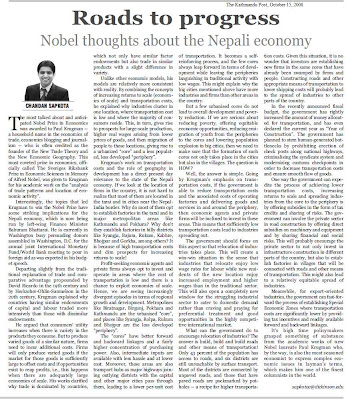This “stylised fact,” that poverty breeds conflict and war, is supported by two empirical papers. Fearon and Laitin (2003) find that lower income per capita increases the likelihood of civil war. They argue that income per capita is a proxy for the state’s overall financial, administrative, police, and military capabilities. If the government is weak, rebels can expect success. Collier and Hoeffler (2004) find that income per capita, which could be related to the viability of rebellion, has considerable explanatory power in civil war regressions. Neither study deals with the possibly endogeneity of war to economic stagnation.
They argue that this line of argument could be accounted for by historical phenomena that jointly determine income evolution and conflict in the post-WWII era. Poverty and civil war could be driven by the same determinants (like colonial history), some of which are missed by in the typical econometric specifications.
A plausible explanation for the results found in the literature, on the strong relationship between poverty and civil war, is that there are some determinants that favour both economic development and peaceful negotiations, which are absent in the traditional specification. If this is the case, then OECD countries are peaceful not because they are rich, but because historically they suffered some circumstances that favoured negotiated settlements and economic development at the same time.
In particular, in a recent paper (Djankov and Reynal-Querol 2008), we show that the statistical association between poverty, as proxied by income per capita, and civil wars disappears once we include country fixed effects. The standard regression in the literature usually omits country fixed effects. In this context, these dummies capture any time-invariant country characteristics that affect the probability of civil war. This is important in the study of the relationship between per capita income and civil war, as some determinants that affect the condition for conflict may at the same time affect the condition for economic development. These results are robust to dividing the sample by 5-years 10-year, or 20-year periods or using annual data. Using a historical sample from 1825 to 2000, divided in periods of 25 and 50 years, produces the same result.
The authors not only look at the relationship between poverty and civil war in recent decades but also go back to history (from 1825 to 2000) and account for historical variables, which they include in their civil war regression. They find that poverty does not have an effect on civil wars. They include variables like European settler mortality rates and the population density. So, the relation between poverty and civil wars is at best indirect.
This finding has a very different policy implication: economic policies to reduce poverty does not necessarily lower the probability of having civil war.
______________________________________________
Update: Fisman and Miguel respond by arguing that in Africa an income drop of 5% increases the risk of civil conflict in the following year to nearly 30%.
If we believe that a direct link connects poverty and violence, then when failing rains create economic hardship, war should follow. In this case, we can actually figure out whether poverty caused violence by isolating rainfall’s effects. Drought and the resulting economic hardship turn out to matter a lot for understanding conflict in Africa. In work with co-authors Shanker Satyanath and Ernest Sergenti of NYU, we find that a 1% decline in national GDP increases the likelihood of civil conflict by about 2 percentage points. So an income drop of 5%—a large but altogether common deterioration in economic conditions, especially when the rains fail—increases the risk of civil conflict in the following year to nearly 30%, up from an already-high average probability of conflict in Africa of around 20% in normal rainfall years. So we find that short-term shocks to income – exactly the type that Djankov and Reynal-Querol purport to study – do trigger violent conflict on the world’s war-prone continent.



